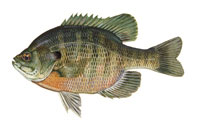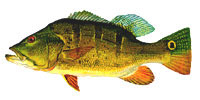Introduced Sport Fishes
Freshwater Game Fishing License required; unlawful to sell.
Largemouth Bass
Micropterus salmoides
| Description | Coloration varies with location, generally dark green above fading to white below; may have faint horizontal band along sides (more distinct in young fish); jaw extends back beyond posterior margin of eye; dorsal fin deeply notched between spiny and soft portions. |
| Size | Weight ranges up to 10 pounds in Hawai‘i; state record 9 pounds 9.4 ounces (1992); world record 22-1/4 pounds (1932, Georgia). |
| Distribution | Kaua‘i, O‘ahu and Hawai‘i. |
| Habitat | Usually found in sluggish waters, occur primarily in reservoirs in Hawai‘i; prefer submerged logs, weeds or other cover near banks. |
| Feeding | Young feed on crustaceans, insects and small fishes; adults feed on live fishes, crayfish and frogs. |
| Life history | In Hawai‘i spawning season occurs during the winter and spring and is limited to reservoir habitats; male builds a circular nest in 3 to 4 feet of water; male guards the nest and defends eggs and young until they leave. |
| Fishing methods | Light spinning or baitcasting gear is recommended, with surface or deep running lures, such as plastic worms, crankbaits or spinnerbaits; effective live baits include puntat, tilapia, crayfish and worms. |
| Note | Introduced to Hawai‘i in 1896. |
Smallmouth Bass
Micropterus dolomieu
| Description | Coloration varies with location, generally dark green to olive brown above lading to white below; sides marked with vertical bars and dark mottlings; jaw does not extend back beyond eye; spiny portion of dorsal fin lower than on largemouth bass, and not as deeply notched. |
| Size | Weight ranges up to 4 pounds in Hawai‘i; state record 4.98 pounds (2004); world record 11 pounds 15 ounces (1955, Kentucky). |
| Distribution | Kaua‘i and O‘ahu. |
| Habitat | Found in cool flowing streams and reservoirs fed by such streams. |
| Feeding | Young feed on crustaceans, insects and small fishes; adults feed primarily on live fishes and crayfish. |
| Life history | In Hawai‘i spawning season occurs during the spring and is limited to stream habitats; male builds a hollow nest in sand and guards the young, viciously attacking any intruder. |
| Fishing methods | Small spinners or poppers are effective lures; live baits include crayfish or worms. |
| Note | Introduced to Hawai‘i in 1953. |
Rainbow Trout
Oncorhynchus mykiss
| Description | Bluish or olive green above fading to silvery below, with broad pink lateral stripe; back, sides, dorsal and caudal fins marked with small dark spots. |
| Size | Generally under 3 pounds, but have unofficially reached 8 pounds in Hawai‘i; state record 5 pounds 10 ounces (1991); world record 48 pounds (2009, Canada). |
| Distribution | Kaua‘i and Hawai‘i. |
| Habitat | Prefers cold water streams with moderate flow. |
| Feeding | Young feed on small insects and crustaceans; adults feed on fish eggs, minnows and other small fish (including other trout). |
| Life history | Limited spawning occurs in Hawai‘i because water temperatures are too high; what spawning does occur takes place from about November to February; annual stockings of the Koke‘e region on Kaua‘i are accomplished with eggs from California, hatched and raised at Sand Island, O‘ahu. |
| Fishing methods | Small spinners or flies are effective lures; salmon eggs are used with good success. |
| Note | Introduced to Hawai‘i in 1920. |
Channel Catfish
Ictalurus punctatus
| Description | Bluish olive to gray above fading to white below, with dark spots scattered along sides; older males become dark in color and lose spots; long barbels surrounding mouth; deeply forked tail. |
| Size | Generally under 10 pounds, but have unofficially exceeded 50 pounds in Hawai‘i; state record 43 pounds 13 ounces (1974); world record 58 pounds (1962, South Carolina). |
| Distribution | Kaua‘i and O‘ahu. |
| Habitat | Occur primarily in reservoirs in Hawai‘i. |
| Feeding | Feeds primarily on small fish, crustaceans, clams and snails. |
| Life history | Spawning occurs in late spring; eggs are laid in jelly-like masses in holes and crevices, and guarded by the male; hatching occurs after about a week, and the male continues to guard the young. |
| Fishing methods | Crankbaits or large spinnerbaits are the most effective lures; a catfish weighing 51 pounds (unofficially) was taken from the Wahiawā Reservoir on a spoon; other baits include tilapia, crayfish, aku belly, liver and various stinkbails. |
| Note | Introduced to Hawai‘i in 1958. |
Bluegill Sunfish
Lepomis macrochirus
| Description | Coloration varies somewhat with sex and age, generally olive green above with blue or purplish sheen along sides; breeding males may have more blue and orange on sides; faint vertical bars along sides; opercular flap is dark blue or black, and prominent dark blotch is present at posterior base of dorsal tin. |
| Size | Generally 4 to 6 inches in length, may reach 14 inches; state record 8-1/2 ounces (2000); world record 4 pounds 12 ounces (1950, Alabama). |
| Distribution | Kaua‘i, O‘ahu, Maui and Hawai‘i. |
| Habitat | Usually found in lakes, ponds, reservoirs and sluggish streams, occur primarily in reservoirs in Hawai‘i; prefer deep weed beds. |
| Feeding | Young feed on crustaceans, insects and worms; adults feed on snails, small crayfish, insects, worms and small minnows; feed mostly in early morning and late afternoon and evening. |
| Life history | In Hawai‘i spawning season occurs in winter and spring; male builds a circular nest in sandy areas 3 to 6 feet deep; after fertilizing eggs male chases female away and guards the nest until fry disperse. |
| Fishing methods | Worms are the most effective live bait; lures include flies and small spinners. |
| Note | Introduced to Hawai‘i in 1946. |
Tucunare
Cichla ocellaris
| Description | Yellow with a green back and white abdomen; vertical bars along sides; during spawning season yellow color intensifies, and males develop a large hump above the head; prominent black spot on caudal fin. |
| Size | Weight averages about 2 to 3 pounds; state record 9 pounds 4.2 ounces (1990); species known to reach 12 pounds in South America. |
| Distribution | Kaua‘i, O‘ahu and Hawai‘i. |
| Habitat | Generally found in the larger reservoirs of the state. |
| Feeding | Feeds exclusively on small fish, especially threadfin shad, mosquito fish, tilapia and bluegill. |
| Life history | Spawning in Hawai‘i occurs from about March to September; eggs are laid on rocks or other hard objects and guarded by one or both parents; hatching takes place within four days, and parents guard the young; presence of at least one parent is essential for survival of young, so fishermen are urged not to disturb spawning fish which are often visible near shore. |
| Fishing methods | Lures include jigs and torpedo-shaped lures that resemble minnows; the only effective live bait is mosquitofish, mollies or tilapia. |
| Note | Introduced to Hawai‘i in 1957. |
